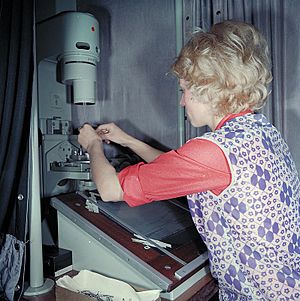Quality control facts for kids
Quality control (often called QC) is a way of checking everything involved in making a product or providing a service. It makes sure that what is being made meets certain standards. The ISO 9000 standard, which is a set of rules for quality, says that quality control is about making sure all the quality rules are followed.
This idea of quality control focuses on three main things:
- Having clear rules, good ways of working, and keeping good records.
- Making sure people have the right skills, knowledge, and experience.
- Having a good team spirit, trust, and motivation among the people working.
A big part of quality control is inspection. This means carefully looking at a product or checking the results of a service. For example, inspectors might have a list of things that are not allowed, like cracks or scratches on a product. If they find these problems, the product might not be approved.
Contents
How Quality Control Started
In the past, things like early stone tools were not made to be exactly the same. But when people started making many items at once (called mass production), they needed parts that were identical. Even with mass production, things could still go wrong. Some customers might get products that were not perfect.
Quality control helps by checking products for problems. It also helps decide if a product is good enough to be sold. For big projects, especially those for governments, not having good quality control can mean a company loses its contract.
The first type of quality control was simple. Workers would compare an item to a drawing. If it didn't match, it was rejected. But making things exactly like a drawing was hard and costly. So, around the 1840s, people started using "tolerance limits." This meant a part was okay if its measurements were within a certain range. Tools like plug gauges and ring gauges were used to check these measurements.
However, this didn't stop products from having problems. Throwing away or recycling faulty items costs money. Companies then looked for ways to reduce these problems. They also tried to decide if it was worth fixing every small issue or if they should use other methods to make production better.
Main Ways to Do Quality Control
Many experts and companies have created their own ways to do quality control. Here are some of the most well-known methods:
| Name of Method | When it Started | What it Means |
|---|---|---|
| Statistical quality control (SQC) | 1930s | Uses math and statistics to check quality. It helps find problems early using special charts. |
| Total quality control (TQC) | 1956 | This idea says that everyone in a company, not just those making the product, should care about quality. This includes people in sales, design, and even accounting. |
| Statistical process control (SPC) | 1960s | Uses charts to watch how a process is working. It helps workers see if their work is staying on track and fix problems quickly. |
| Company-wide quality control (CWQC) | 1968 | This is the Japanese way of doing total quality control, meaning everyone in the company is involved. |
| Total quality management (TQM) | 1985 | A method from the United States that uses statistical tools to constantly make a company better. |
| Six Sigma (6σ) | 1986 | A business strategy that uses statistics to find and fix mistakes. It was first used by Motorola. |
| Lean Six Sigma (L6σ) | 2001 | Combines Six Sigma with "lean manufacturing" ideas. Lean manufacturing focuses on reducing waste and making things more efficient. |
Quality Control in Projects
In project management, quality control means that the project leader or team checks the work that has been done. They make sure it matches what the project was supposed to achieve. Often, big projects have a special team just for quality control.
See also
 In Spanish: Control de calidad para niños
In Spanish: Control de calidad para niños
- Analytical quality control
- Corrective and preventative action (CAPA)
- Eight dimensions of quality
- First article inspection (FAI)
- Good Automated Manufacturing Practice (GAMP)
- Good manufacturing practice
- Quality assurance
- Quality management framework
- Standard operating procedure (SOP)
- QA/QC


